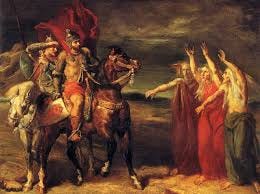Witches and Murderers? Where did Macbeth come from?
Reading Off the Beaten Path
Macbeth, “The Scottish Play.”
This piece is not exactly in my wheelhouse, but I've always liked Shakespeare and loved Scotland, and thought I'd give a little background about the underpinnings of Macbeth. I’ll include a disclaimer right now, however: I'm don’t claim to be 100% historically accurate here. I’ll be pretty close, but simply want readers to get the spirit of how Macbeth came to be.
While it’s factual that an individual named Shakespeare lived in Stratford-on-Avon in the late 1500s, one of literature’s great debates rages on as to whether this country person did in fact author all the many plays, poems, and sonnets attributed to him. [Here's one link that discusses this issue Doubting Shakespeare.) It's often pointed out that the actual Shakespeare never ventured far from his home in England. Yet he wrote prolifically – if not lovingly and cunningly -- about foreign countries.
For example: plays set in Italy include, Taming of the Shrew, Two Gentlemen from Verona, Merchant of Venice, and Much Ado about Nothing, not to mention Romeo and Juliet, Julius Caesar and Othello. He never went to Denmark but perhaps his greatest tragedy is Hamlet, set there in Elsinore Castle. Measure for Measure is based in Vienna, Twelfth Night in Yugoslavia, Midsummer Night's Dream in Greece, Anthony and Cleopatra in Egypt. How this poor bloke from a little town in rural England knew so much about diverse European history is truly up for conjecture. But that's for others to write about. Our story today is about Macbeth, which takes place in Scotland. As Shakespeare’s only play based there, it's known as “The Scottish Play.”
Macbeth is considered one of Shakespeare's greatest tragedies. Here's my attempt to summarize a truly masterful and complex Shakespearean work in just a few lines: In the Highlands of Scotland, Macbeth is a prominent General in King Duncan's army. Macbeth runs into three witches who tell him a prophecy: one day he’ll be King of Scotland. Astonished to hear his destiny from these witches, he shares the news with his wife, Lady Macbeth. She’s more devious than he, and she sets out to help fulfill his destiny to become King of Scotland. King Duncan shows up in Macbeth 's castle where Lady Macbeth pushes her husband to kill the King. He reluctantly agrees. Macbeth stabs the King (considered one of the great murders in literature!) but tells everyone the guards did the job. In any case, the King is dead and therefore the prophecy is true and Macbeth becomes King. Macbeth feels terrible, becomes paranoid and loses his mind. He goes on to kill the heir to the Scottish throne, returns to the witches, and continues his murderous rampage. Lady Macbeth is wracked with guilt and tragically kills herself. King Duncan’s son sets out to avenge his father’s death at the hands of Macbeth. But a fellow named Macduff turns up, whose wife and child were killed by Macbeth. Macduff challenges Macbeth to a duel, and in the end, Macbeth is beheaded. As you can see, this is a wild story about scary witches, palace treachery, and murders in the Highlands of Scotland.
First, make no mistake: Macbeth is a true villain. He’s not considered a Shakespearean hero, or great protagonist. He’s simply a bad guy. And if you were watching this wild man in the Globe Theater in London in 1610, you would hate him. The happy ending of the play is when Macbeth dies. A one-line summary would be, An evil man, inspired by dark witches, tries to overthrow the rightful King of Scotland. This is a tragedy because at the outset, neither Macbeth nor Lady Macbeth are bad people; but they become murderers (after meeting witches?) and spiral down. Way way down.
Macbeth was written in 1609. How did Shakespeare dream up such a plot? Where in the world did he get the background information for the play?
It turns out that Shakespeare drew the plot for Macbeth from actual history. Over 500 years before there truly was a Scottish King named Duncan. He had a rival to the south named Mac Bethad mac Findlaich. King Duncan was in fact killed (in battle) by Mac Bethad mac Findlaich, who then took the Scottish throne and became King from 1040 to 1057. About 20 years later, King Duncan's son would avenge his father's murder by killing Mac Bethad in return.
So more than 500 years later, in 1609, why did this relatively obscure Scottish quarrel seem so attractive to Shakespeare? Because of English society in the 1590s. First, the persecution of witches and witchcraft was at its height. Second, Scotland was still considered a rogue state of sorts.
James I was King of England. (He came from Scotland when his predecessor had no direct heir; the son of Mary Queen of Scots, James I was the closest relative. He was considered scholarly and reigned over a golden age of literature in England that included Shakespeare, John Dunne, and Sir Frances Bacon. James pushed for a more readable Bible, and his translation -- the King James Bible -- is still widely read today., Finally, he himself wrote a 90 page book about witchcraft.)
Witchcraft was at the forefront of society in those days. For us today, it’s astonishing that witch trials and executions could possibly take place on such a large scale. But understand that witchcraft was deemed the evil branch of theology; the Devil had a very active hand in daily life in 1600, and he acted in part through witches. James I and many others felt threatened by witches and in fact in 1590 James uncovered a plot to take away his crown and murder him. Over 300 witches went on trial, leading to torture and many deaths. James personally presided over this trial. A witch could pervade society anywhere. In large part, Shakespeare wrote for this witch-fearing audience.
So with witches and throne-seizures on the brain, Shakespeare's play Macbeth came out and painted the evil over-throwers in as bad a light as possible. This was Shakespeare's way of buttering up to James I. Knowing that James and the audience thought that witches were out to get them, Shakespeare made them to be as reprehensible as possible. It’s no wonder that in most traditional depictions of this play, the scenes are dark, sullen, brooding. The stage is eerie and creepy. To make the three witches as despicable as possible, Shakespeare portrayed them as nasty biddies. Our modern image of a witch being a withered old hag comes directly from Macbeth.
Macbeth’s underpinnings went further. As a Londoner in 1609, you knew full well Scotland was a wild and lawless nation. It had always sent raiders and brigands into civilized England. It was known as unpredictable, a land of pillagers, intrigue, and brutal characters. Macbeth represents this evil north, always a threat to England. He amplifies this stereotype. It was exciting for audiences to see King Macbeth fulfill their image of a Scotsman: the lunatic doing the unthinkable.
James I strove to unify Scotland and England. In Shakespeare's eyes, Macbeth stands for Scotland’s last Celtic King. Shakespeare loved to ingrain the image of the rowdy Scots, always a thorn to England. Putting the detestable Macbeth to death was his way of wishing death to the Scottish nation.
Shakespeare tried hard to promote James I’s moral and political agendas. Pulling from historical fact and somehow aware of Scottish intrigue over 500 years before, he linked these historical threads into the contemporary topics of witchery, overthrow, and Scottish rebellion. When audiences saw witches in the Globe Theater in 1609, they must’ve gone crazy. When they saw the Scottish madman Macbeth, even more so. But when the tyrant is beheaded in the end, everyone went home with a smile on their face.
Thank you for reading and sharing as always.
I write entertaining novels that get great reviews from readers of all ages. My 7th book will be out soon; ZIN MIGNON and the MUSTARD MONKS is the fourth in the ZIN series, about the perils and pleasures of 13-year old celebrity Chef Zin Mignon. You do NOT have to love cooking or food to love Zin. (4th book solves the mysteries and provides countless revelations. Lotsa fun.) www.michaeldaswick.com
MD in AZ




